By Representative David Gomberg, House District 10
8/28/2023
Hello Neighbors and Friends,
While I was over at the Eastern Oregon Economic Summit, I got a chance to sit down and catch up with Oregon Treasurer Tobias Read. Tobias is an old friend who I served with in the House. For the past seven years, he has been quietly and effectively managing Oregonians’ money. The results are impressive with annual returns averaging 10-12%.
Oregon State Treasury improves the financial well-being of Oregon and Oregonians, providing debt management and investment programs for state funds like PERS, returning money to residents, and empowering people to invest in themselves. Here are a few examples.
Unclaimed Property: In July 2021, the state’s Unclaimed Property Program transitioned to Treasury from the Oregon Department of State Lands. This property can include money from forgotten bank accounts or investment accounts, checks that were never cashed, unclaimed tax refunds or overpayments on utility bills. Treasury then set up a simple web page at unclaimed.oregon.gov where you can quickly see if funds are being held for you. Take a moment and try it!
Since the transition to Treasury, the program has completed over 47,000 claims, returning over $538 million to current and former Oregonians.
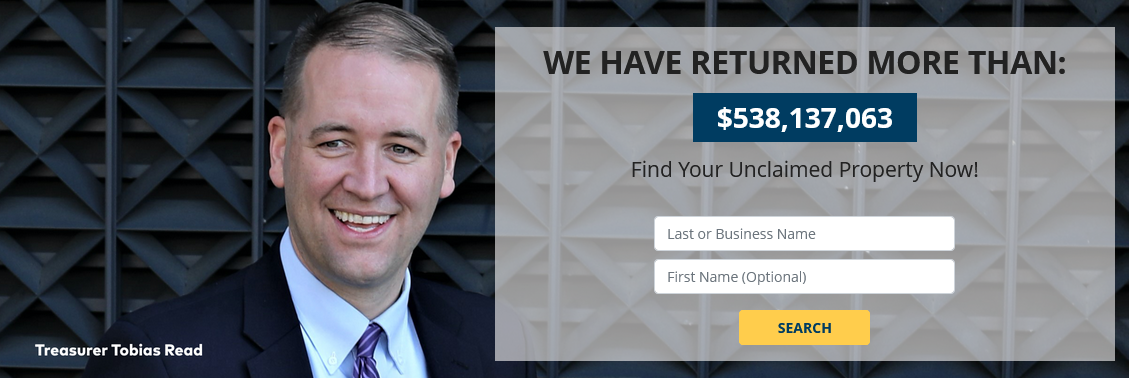 And now, Treasury is proactively reaching out to people and returning money to them. We’ve all learned to be suspect of unexpected checks in the mail or letters from strangers who say they have money for us. But in this case, it’s real! So far this year, Treasury has returned approximately $10 million in unclaimed funds as part of the “Checks Without Claims” initiative. It is the largest mass disbursement of funds by Oregon’s Unclaimed Property Program to date.
And now, Treasury is proactively reaching out to people and returning money to them. We’ve all learned to be suspect of unexpected checks in the mail or letters from strangers who say they have money for us. But in this case, it’s real! So far this year, Treasury has returned approximately $10 million in unclaimed funds as part of the “Checks Without Claims” initiative. It is the largest mass disbursement of funds by Oregon’s Unclaimed Property Program to date.
Ten million is a small fraction of the nearly $880 million in unclaimed property stewarded by the state. Check that web page and see if Oregon has something that belongs to you!
Oregon College Savings Plan: The Oregon College Savings Plan is a state-sponsored 529 plan that anyone can open. It comes with special tax advantages and earns interest just like any other college savings plan. The plan gives families, and future students, low-cost investment options to put away money and spend it tax-free on college expenses like tuition, books, room and board, computers and more.
Treasurer Read says there are two parts of the college savings program he wants to make sure everyone knows about. The first is the Baby Grad program where anyone who opens an account before their child’s first birthday receives an automatic $25 contribution from the state. The same goes for the Kinder Grad program. Anyone who opens an Oregon College Savings Plan for their kindergartener will get a $25 contribution from the state.
Accounts can be opened for as little as $25. People who have an Oregon College Savings Plan for their child can receive up to $300 a year in state income tax credits.
Another way families can save for their children’s future is by returning their cans and bottles. Anyone who visits a BottleDrop location can put their deposit directly into their child’s Oregon College Savings Plan. Other people can also donate to a child’s savings plan by linking their BottleDrop account to it through a custom gifting page. The state has directions online for how to do this.
Research done by the University of Michigan’s Center on Assets, Education & Inclusion found that a child from a low- or moderate-income household who has a college savings account of $1 to $499 before they reach college age is over three times more likely to enroll in college and four times more likely to graduate college than a child without a savings account.
The Oregon College Savings Plan has $2.6 billion in assets as of today. That’s right around 155,000 investors. The fairly new program has distributed $170 million to students for college expenses so far.
If a child decides not to pursue any sort of higher education, Oregon College Savings Plans can be transferred to relatives or withdrawn with appropriate penalties.
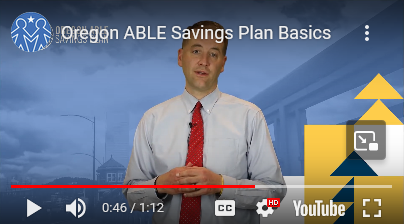 Oregon ABLE Savings Plan: More than half a million Oregonians, nearly 15 percent of the state’s population, have a disability. Many are forced to live in poverty to qualify for benefits, particularly Medicaid health coverage.
Oregon ABLE Savings Plan: More than half a million Oregonians, nearly 15 percent of the state’s population, have a disability. Many are forced to live in poverty to qualify for benefits, particularly Medicaid health coverage.
Those benefits are only available to people with limited assets. That prohibits recipients from accumulating property, vehicles and more than a limited amount of money. If someone receiving benefits were to go over the limit, they would be disqualified. It could take months or even years to requalify for benefits.
But Oregonians with disabilities are now able to save money without bumping up against these limits with ABLE Savings Plan accounts.
Congress signed the ABLE Act into law in 2014 to encourage people with disabilities and their families to save money, but it was up to each state to implement it. Oregon officially signed it into law in 2016. The program is run by the Oregon State Treasury.
Oregonians with disabilities can deposit up to $15,000 a year in such an account and accumulate up to $100,000 without affecting their benefits. They can deposit an extra $12,000 if they are employed and stay covered under Medicaid, although they may lose other benefits. Family members or friends can contribute too.
Money saved in the special accounts must be used for living expenses or costs relating a disability, such as education, housing, transportation and medical costs not covered by insurance.
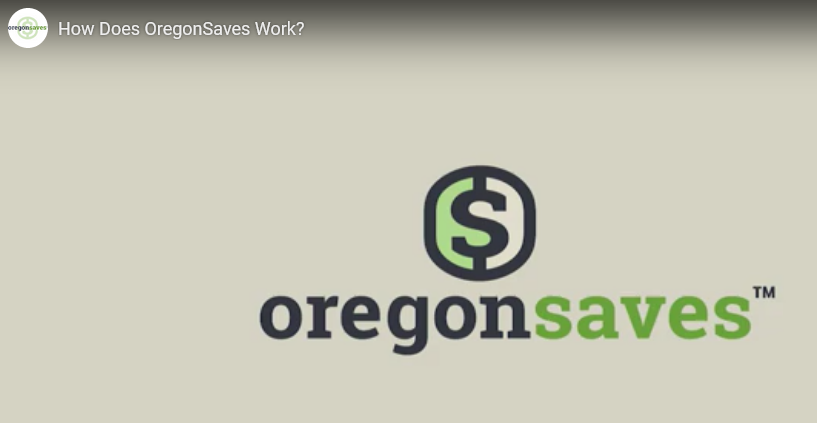 OregonSaves: Too many Oregonians face a retirement crisis – either ending work and living on much less, or continuing to work. OregonSaves is the state of Oregon’s retirement savings program that provides Oregonians with an easy and automatic way to save for the future. All Oregon employers are now required by law to participate in OregonSaves if they don’t offer a retirement plan for their employees.
OregonSaves: Too many Oregonians face a retirement crisis – either ending work and living on much less, or continuing to work. OregonSaves is the state of Oregon’s retirement savings program that provides Oregonians with an easy and automatic way to save for the future. All Oregon employers are now required by law to participate in OregonSaves if they don’t offer a retirement plan for their employees.
Launched with a pilot phase in July 2017, OregonSaves became the nation’s first state-based effort to address the retirement savings crisis by ensuring all private sector workers have the opportunity to save. Over time, the program expanded statewide in waves, starting with the largest employers, and last month began including those with four or fewer employees. Many businesses and employees are still adjusting to the new requirements.
Early research found that as many as one million Oregonians—representing about half of the workforce—lacked access to a workplace-based retirement savings plan and would be eligible to participate in OregonSaves. At the same time, surveys by the AARP found that workers are 15 times more likely to save if they can do so via payroll deductions. Six years in, nearly 118,000 workers from more than 21,000 businesses statewide are saving with every paycheck in their own Individual Retirement Accounts (IRAs)—more than $200 million managed by Oregon State Treasury.
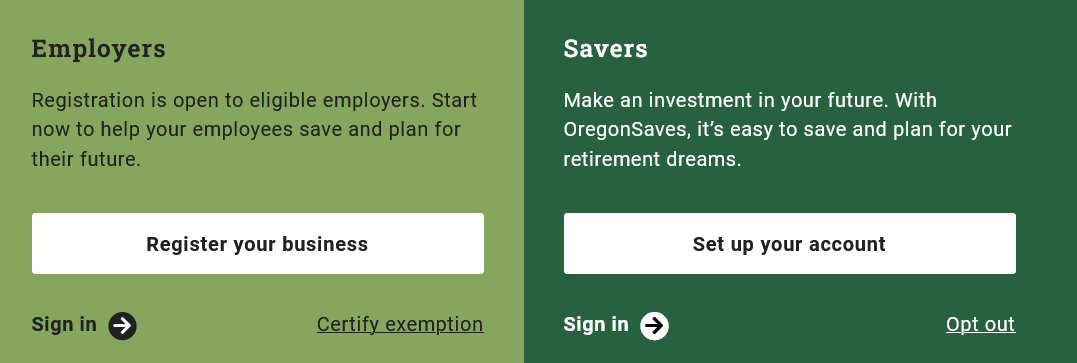 Employees contribute part of their paycheck into their own personal IRAs that stay with them throughout their careers if they change jobs. Importantly, employees can opt out of the program. The program also benefits employers who don’t offer a qualified retirement plan by helping them compete with businesses that do. The program is overseen by the Oregon Retirement Savings Board.
Employees contribute part of their paycheck into their own personal IRAs that stay with them throughout their careers if they change jobs. Importantly, employees can opt out of the program. The program also benefits employers who don’t offer a qualified retirement plan by helping them compete with businesses that do. The program is overseen by the Oregon Retirement Savings Board.
OregonSaves defaults to employees setting aside 5% of their salary unless they choose to leave the program or change their contribution amount. The average enrollee is investing $174 per month and setting aside 6.5% of their gross income.
Full disclosure: When this proposal was before the legislature in 2017, I voted against it. I saw a clear problem that not enough Oregonians were saving for the future. But I also worried about yet another administrative burden for our smallest businesses and feared they would have to keep doing the paperwork even if employees opted out. Statewide, 23.3% of employees opt-out of OregonSaves.
Now 13 states have followed Oregon with similar retirement programs, including California. Twenty-two other states have proposed legislation this year to copy OregonSaves to their own state.
To learn more about OregonSaves or to open an account, please visit www.oregonsaves.com.
|
|
Last Thursday, a dozen Oregon Legislators and a dozen Oregon wineries met at Sokol-Blosser to form the Oregon Legislative Wine Caucus. I’m honored to be asked to co-chair the group together with Representative Lucetta Elmer (R-McMinnville).
A “caucus” is an informal group of Senators and Representatives working on an area of particular interest. In the case of a Wine Caucus, legislative issues could include farming practices, with an eye on sustainability and environmental stewardship, expanding the Oregon Bottle Bill to include wine bottlers, how possibly selling more spirits in grocery stores could affect shelf space for wines, and ensuring that out-of-state wineries that purchase Oregon grapes pay the Oregon tonnage tax.
Oregon currently enjoys more than 1,000 wineries and 1,400 vineyards, with around 42,000 planted acres of wine grapes — all of which generates more than $7 billion in total economic activity for Oregon. With changes in legislative boundaries that went into effect in January, I’m now proud to represent the excellent wineries and vineyards of Western Lane and Benton Counties.
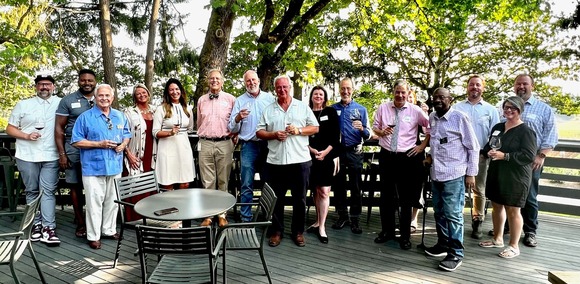 The Caucus will work in cooperation with the Oregon Wine Board, the Oregon Winegrowers Association (OWA) and Oregon Wine Council (OWC).
The Caucus will work in cooperation with the Oregon Wine Board, the Oregon Winegrowers Association (OWA) and Oregon Wine Council (OWC).
I have long been involved with Oregon wines and actually helped clear land for Willamette Valley Vineyards near Salem forty years ago. I led efforts to address false labeling when a California producer began selling the “Oregon Coast Pinot Noir” with grapes from the Rogue and Umpqua Valley. And I helped the Solidarity wines to support vineyards impacted by smoke taint in 2020.
Attending the afternoon reception were Sokol Blosser Winery, Rex Hill/AtoZ Wineworks, Willamette Valley Vineyards, Amaterra Winery, Ponzi Vineyards, Stoller Winery, Winderlea Vineyards, King Estate, Joyful Noise Winery, and NW Wine Company.
 Another highlight last week was celebrating the new Sea Lion Docks ribbon cutting at Port Dock 1 with the Newport Chamber of Commerce and the after-party at the Clearwater. I told someone there the gathering sounded like a meeting of our own State Senate! Take a listen for yourself!!
Another highlight last week was celebrating the new Sea Lion Docks ribbon cutting at Port Dock 1 with the Newport Chamber of Commerce and the after-party at the Clearwater. I told someone there the gathering sounded like a meeting of our own State Senate! Take a listen for yourself!!
In the coming week I plan to celebrate a new Lincoln City Park, attend concerts with the Siletz Bay Music Festival, and cut ribbons at the new Grocery Outlet, Coyote Gallery, and Shoreline Smoothies.
I have meetings about offshore wind energy, debt collection, trade with Taiwan, state revenue forecasts, the recall election in Eugene, and the status of wildfires across Oregon.
Later in the week, Susie and I are taking a two-day getaway for our 38th anniversary. We’ll be back for the Siletz Bay Music Festival gala and dance Friday evening. Saturday I’m scheduled to speak in the morning in Florence and picnic with the local Audubon Society at Rocky Creek State Scenic Viewpoint.
Monday of course is Labor Day. Please take time during the long weekend to celebrate the social and economic achievements of American workers. Our weekly newsletter will be back on Tuesday.
P.S. – Due to technical issues we are still sorting out with the legislature’s Information Services team, many email responses to our last newsletter were not received by our system. If you are awaiting a reply from us, please know that we are doing our best to follow up with you. Thank you for your patience as we work to resolve the issue.
If you have a time-sensitive question or request that has been waiting, please feel free to email us again directly at Rep.DavidGomberg@OregonLegislature.gov
|
|
email: Rep.DavidGomberg@oregonlegislature.gov
phone: 503-986-1410
address: 900 Court St NE, H-480, Salem, OR, 97301
website: http://www.oregonlegislature.gov/gomberg


